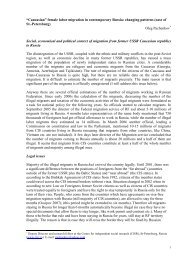THORIUM AS AN ENERGY SOURCE - Opportunities for Norway ...
THORIUM AS AN ENERGY SOURCE - Opportunities for Norway ...
THORIUM AS AN ENERGY SOURCE - Opportunities for Norway ...
You also want an ePaper? Increase the reach of your titles
YUMPU automatically turns print PDFs into web optimized ePapers that Google loves.
Nuclear Reactors <strong>for</strong> Thorium<br />
removal of the nominal power by pure natural circulation <strong>for</strong> a certain time. However, this would<br />
still require a complete heat removal by the secondary loops.<br />
In a Loss-Of-Heat-Sink (LOHS) Accident, the core would slowly heat up (by about 200ºC in 1000<br />
seconds). Switching off the accelerator would get the power rapidly down to decay heat level. In<br />
case this shutting off is not done, one can rely on a simple passive means of interrupting the<br />
proton beam by using a melt-rupture disk at the side of the vacuum pipe through which the<br />
protons are streaming into the subcritical core [118], [123]. When this melt rupture disk is pushed<br />
inside the pipe by the coolant pressure, the pipe will be unconditionally filled up by the liquid<br />
metal coolant that will block off the proton beam.<br />
An important initiator <strong>for</strong> Loss-Of-Flow and Loss-Of-Heat-Sink accidents is a station blackout.<br />
However, in an ADS this would also lead to the shutting off of the accelerator and the decrease of<br />
the power to decay heat level. The remaining problem would be the passive decay heat removal<br />
that can be achieved by natural air circulation cooling.<br />
Loss-Of-Coolant (LOCA) Accidents, which are a concern in LWR safety, should pose no significant<br />
problem. First, a lead-bismuth (Pb-Bi) cooled system is at a low pressure; second, a pool design<br />
has been proposed in which all the primary coolant is in one vessel and there is no primary piping<br />
which might develop leaks; and third, a guard vessel surrounds the main vessel in case the latter<br />
would leak. Another important safety aspect of a lead-bismuth or lead coolant is that it is<br />
chemically rather inert and does not react strongly with air or water. This is an advantage<br />
relative to sodium-cooled fast systems.<br />
Beam Power Accidents. Since the proton beam intensity can be increased to compensate <strong>for</strong> burnup,<br />
one can also imagine that the beam power is increased accidentally. Figure 5.13 shows the<br />
power increase with an assumed beam power increase by a factor 2 in one second [118], [124].<br />
According to accelerator specialists, this large increase is not credible. It can be seen that the<br />
power does not increase too much and levels off at about 1.5 times nominal. The elevated power<br />
leads to some pin failures after about 16.5 seconds. This would not have happened if the beam<br />
power was shut off actively or passively.<br />
Figure 5.13: Assumed Beam Power Increase by a Factor of 2 in One Second.<br />
Reactivity Accidents: It has also been realised that fast reactivity insertions do not lead to rapid<br />
power increases due to the subcriticality of an ADS which acts as a large delayed neutron group<br />
[124]. Figure 5.14 shows the power and reactivity histories due to a reactivity insertion of 170$/s,<br />
63

















